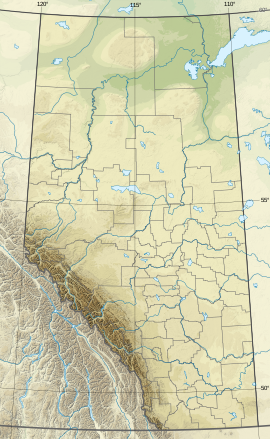Evelyn Peak
| Evelyn Peak | |
|---|---|
 Evelyn Peak seen from Bald Hills | |
| Highest point | |
| Elevation | 2,855 m (9,367 ft)[1] |
| Prominence | 435 m (1,427 ft)[1] |
| Parent peak | Mount Kerkeslin (2950 m)[1] |
| Coordinates | 52°40′18″N 117°45′43″W / 52.67167°N 117.76194°W |
| Geography | |
| Location | Jasper National Park Alberta, Canada |
| Parent range | Maligne Range Canadian Rockies |
| Topo map | NTS 83C/12 |
| Geology | |
| Age of rock | Cambrian |
| Type of rock | Sedimentary rock |
| Climbing | |
| Easiest route | Scrambling[2] |

Evelyn Peak is a 2,855 m (9,367 ft) mountain summit located in the Athabasca River valley of Jasper National Park, in the Canadian Rockies of Alberta, Canada. Its nearest higher peak is Mount Kerkeslin, 5.0 km (3.1 mi) to the southwest, and Mount Hardisty is situated 6.0 km (3.7 mi) to the northwest.[1] All three are part of the Maligne Range. Evelyn Peak is composed of sedimentary rock laid down during the Cambrian period and pushed east and over the top of younger rock during the Laramide orogeny.[3] The mountain is located at the headwaters of Evelyn Creek[4], and three kilometers south of Evelyn Pass.[5] The creek and pass were named in 1921 for Evelyn Cavendish, Duchess of Devonshire (1870–1960), who visited nearby Maligne Lake in 1920.[6] The mountain's name however, has not yet been officially adopted by the Geographical Names Board of Canada.
Climate
Based on the Köppen climate classification, Evelyn Peak is located in a subarctic climate with cold, snowy winters, and mild summers.[7] Temperatures can drop below -20 °C with wind chill factors below -30 °C. Precipitation runoff from Evelyn Peak drains into the Athabasca River.
See also
References
- ^ a b c d "Evelyn Peak". Bivouac.com. Retrieved 2019-04-04.
- ^ "Evelyn Peak". explor8ion. Retrieved 2019-04-05.
- ^ Gadd, Ben (2008). "Geology of the Rocky Mountains and Columbias".
{{cite journal}}: Cite journal requires|journal=(help) - ^ "Evelyn Creek". Geographical Names Data Base. Natural Resources Canada. Retrieved 2019-04-04.
- ^ "Evelyn Pass". Geographical Names Data Base. Natural Resources Canada. Retrieved 2019-04-04.
- ^ Place-names of Alberta. Ottawa: Geographic Board of Canada. 1928. p. 49.
- ^ Peel, M. C.; Finlayson, B. L.; McMahon, T. A. (2007). "Updated world map of the Köppen−Geiger climate classification". Hydrol. Earth Syst. Sci. 11: 1633–1644. ISSN 1027-5606.
{{cite journal}}: Unknown parameter|last-author-amp=ignored (|name-list-style=suggested) (help)
External links
- Parks Canada web site: Jasper National Park


